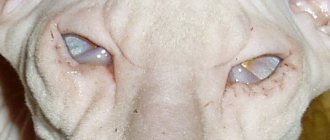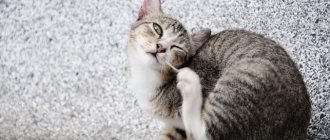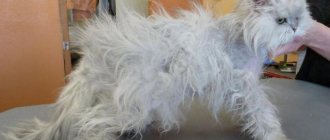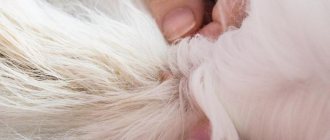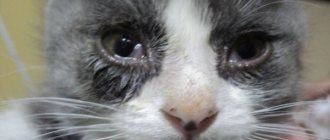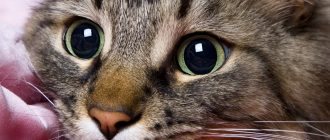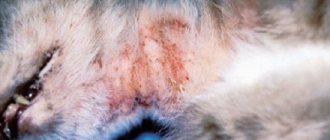Description of diseases and defects of the Don Sphynx
The Canadian, Don and St. Petersburg Sphynxes are the main representatives of the hairless breed.
Hairless cats from St. Petersburg are known as Peterbalds. Each type of such cats has its own breed characteristics. It is impossible to describe the Canadian Sphynx breed without describing the incredible number of folds; the more folds there are, the higher the animal is valued. Canadians have large numbers of them on their faces. There is so much bare skin that even if the animal stretches out to its full length, it will still remain unmelted to the end. To say that such a cat is completely hairless would be incorrect. The skin of sphinxes is covered with light fluff, which feels like suede or peach peel. Short hair can be on the paws, scrotum, and the outer part of the ears. On a thin, graceful and bald tail, a small tassel is allowed at the end.
- The body is medium sized, muscular and very hot. The body has a wide chest, sometimes in the shape of a barrel.
- The limbs are slender and muscular, the hind legs are longer than the front legs. The finger joints are clearly defined. The paw pads are thick and match the general coloring.
- The cat's head is wedge-shaped with prominent cheekbones and a straight nose.
- The neck is muscular and long.
- There are small folds of skin on the head.
- Important characteristics of cats are their eyes, which are shaped like lemons, and huge, erect ears, pointed or round in shape.
- Canadians may have heterochromia in one or both eyes.
- Despite the fact that their ancestors had mustaches, the sphinxes did not inherit them.
- The largest sphinxes weigh no more than 5-6 kg.
Sphinxes can look a person in the eyes continuously for a long time. And it’s difficult for the owner to take his eyes off the pet’s huge, slightly slanted, attentive eyes. The expression is such that it may seem as if he is ready to jump.
A carp bite (shortened lower jaw) is a congenital disorder of the ossification of the jaw. Malocclusion occurs in all domestic animals, but is most common in the Don Sphynx.
A violation is considered to be a displacement of two rows of incisors that cannot align. The violation occurs due to the arrest of the animal's growth at the moment when the symphysis in the lower jaw of the incisive bone ossifies prematurely.
Sometimes such a defect is mild and does not bother the animal. Long fangs can injure the upper jaw, which quickly develops painful “pockets.”
Because of such “pockets,” the cat develops gingivitis. The short lower jaw of the Sphinx is formed due to underdevelopment of the tail vertebrae, stunted growth and dwarfism.
Sphynxes with this pathology are not suitable for reproduction.
Microphthalmos is abnormal development of the eye, decreased vision or blindness. With microphthalmia, the eyeball is reduced.
Microphthalmos is closely associated with other eye defects: cataracts and congenital keratitis. Many kittens are born with open eyes, tumors, an orbital cyst, and an incomplete palpebral fissure.
These defects are noticeable immediately after birth or after 7–10 days. Sometimes it is impossible to do without the intervention of plastic surgery.
But even surgery will not completely remove these defects.
Developmental defects
Hairless sphinxes were specially bred through inbreeding in order to consolidate the mutation of “rubbery” smooth skin and an abundance of folds. As a result, animals were prone to abnormal development of a number of organs: eyes, jaws, spine, intestines.
Shortening of the lower jaw
Another name is “carp bite.” A congenital pathology of smooth-haired pets, manifested by shortening of the lower jaw. Its growth stops prematurely due to early ossification of the symphysis in the incisor area.
The disease is manifested by the following symptoms:
- the rows of incisors do not align or touch;
- distortions of the jaw, narrowing of the arch;
- asymmetry of the dentition;
- tongue hypoplasia;
- on the hard palate there are ulcers and inflammations from dental injuries.
With mild manifestations, sphinxes adapt and can eat solid pieces of food.
Microphthalmos
Improper formation and development of the eye leads to a decrease in its size. Accompanied by decreased visual acuity, keratitis, coloboma and cataracts.
This disease can be detected in kittens at birth. They are born with open eyes, tumors and eye cysts. One of the causes of the anomaly is intrauterine chlamydia.
Scientists have proven the connection of the disease with reduced fertility of small animals.
Something else interesting: Treatment of eyes in cats - cataracts, conjunctivitis, nasolacrimal duct obstruction
Congenital entropion of the eyelids
Externally, the pathology looks like an inward turning of the eyelids. The eyelashes and the edge of the eyelids curl up and touch the membrane of the eye. As a result, animals from birth suffer from continuous conjunctivitis and inflammation of the sclera. Surgeons perform surgical interventions for correction, as a result of which minor improvements are possible.
Curvature of the caudal spine
The defect often occurs in kittens born after inbred crossing. Every second litter is characterized by such a congenital disease. Animals often turn out to be non-viable, since additional serious defects are simultaneously detected in them:
- anomaly of the intestine, mainly the thick section;
- weak rectal sphincter;
- reduced height;
- underdevelopment of the thoracic and lumbar vertebrae.
Nipple hyperplasia
It is inherited through the female line. Scientists have proven the connection with the characteristic color and eye color.
The following animals are mainly affected:
- with light blue skin;
- blue-cream;
- with blue eyes.
The disease manifests itself and progresses gradually. When female kittens turn one year old, their nipples turn red. Over time, the skin around the nipple thickens and becomes keratinized. The nipple itself takes the shape of a club and increases in size. Cysts often appear.
In such mother cats, babies are often born with pathologies of internal organs and die at an early age due to the incompatibility of severe defects with life. The birth itself is difficult due to the weakness of labor. Little milk is produced.
One of the proven causes of hyperplasia is taking medications that suppress sexual activity. At the same time, unilateral or bilateral ovarian cysts form. Surgical treatment: sterilization, nipple removal.
Underdevelopment of the thymus
Kitten falling asleep syndrome is also called pathological underdevelopment of the thymus. Outwardly healthy kittens, who had just eaten or played, begin to die one by one - they literally fall asleep.
The most common cause of mass death of kittens of the same litter is inbreeding. Babies have a very low survival rate. Already in the first days, some people clearly notice the following signs:
- bluish skin on the face and paws;
- growth retardation;
- parchment leather;
- weak, sluggish sucking.
Even attempts at artificial feeding do not help. Babies die within a period of several days to weeks.
Gingival hyperplasia
Accompanied by pathological growth of mucous tissue, up to the closure of the surface of the teeth. It manifests itself as increased bleeding, pain, and a high risk of bleeding when eating solid food or cartilage. Does not affect other structures of the oral cavity (tongue, cheeks). It occurs chronically. Blue cats are most often affected.
Something else interesting: Causes of cones in cats and rules for helping your pet
Feeding adult cats and kittens
Kittens' bodies grow until they are 10 months old, so they need nutritious food. Already from the first months of life, sphinxes are accustomed to solid food and given boiled veal. Pork is prohibited (by the way, as is lop ears), as it is fatty and can cause digestive problems.
At 4 months, small quantities of sea fish with the bones removed will be useful. From 6 weeks it is allowed to give yolk and cottage cheese. The owner himself chooses the number of feedings, but it is recommended to accustom the animal to a specific regimen.
The animal should have free access to food, they are not prone to overeating, but food helps them stay warm when freezing.
The basic rules for feeding Sphynx kittens, which they get used to and then eat like this for the rest of their lives, are:
- The menu must include meat. The daily norm is 30% of the body weight of a kitten or adult cat. Healthy protein is also present in fish and cottage cheese. You need 200 g per day.
- One third of your diet should consist of carbohydrates. These are a variety of porridges - buckwheat, rice, oatmeal. The Sphynx also needs fresh vegetables with the addition of 5 - 10 g of unrefined sunflower oil.
- In winter, portions for your pet should be larger.
- Sphynx cats have an accelerated metabolism, which requires a large amount of energy from food.
- You can also feed your animal with ready-made food - but not below premium class. This food must be selected specifically for this breed.
The health of the growing body will depend on the correctness of the diet.
The mechanism of acne
The development of the pathological process is directly related to the disruption of metabolic processes in the skin, and specifically to perverted keratinization (a complex biochemical reaction with the formation of fat, amino acids and keratin, which give the dermis strength and elasticity) and improper functioning of the subcutaneous glands.
Normally, the dead upper stratum corneum of the epithelium is constantly sloughed off, giving way to a newer and younger one. With pathology, normal exfoliation does not occur, and old cells mix with new ones, creating mountains of scales glued together with sebaceous secretions.
Naturally, such a accumulation of cells will sooner or later lead to clogging of the pores, which is externally manifested by black subcutaneous dots. By the way, acne can also be white; this phenomenon is usually observed when the “plug” is located deep inside the pore and does not come into contact with air.
How to care for a Canadian kitten at home
It is recommended to purchase a Sphynx kitten at the age of 3 months.
The animal's insufficient age will create many problems. And by the age of 3 months, the baby is already toilet trained, eats on his own, and parting with the cat will not be painful for him.
The breeder must give recommendations on care and feeding rules. The new owner should maintain contact with the breeder in order to get professional advice if necessary and not seek rash advice from outsiders.
It is imperative to maintain the same nutrition by specifying the kitten’s habits and favorite foods. The same applies to the feeding regime. The main nuances of the establishment of Sphynx kittens are as follows:
- 6 meals a day until the age of 6 months;
- 3 feedings a day up to 9 months;
- after 9 months of feeding 2 – 3 times a day;
- mandatory training in bathing and other grooming procedures.
Caring for a Sphynx requires paying enough attention to its toilet.
A pet of this breed will never go into a dirty litter tray and will eventually choose another place in the house. It is useless to scold for this, since a dirty tray is the owner’s fault. The filler should not be allergenic. From the first days, the kitten needs to be shown the place of the tray, so that later he knows and understands it.
Caring for the Canadian Sphynx
At first glance, it seems that the absence of hair makes the process of caring for the Canadian easier. But it is not so. The unusual appearance also requires special care for the animal. Such energetic pets have an excellent appetite and are not picky about food. This does not mean that the cat's diet should contain what it wants to eat. The pet's menu should consist of a variety of products that provide a balanced supply of essential substances and vitamins. Sphinxes can eat both special food and natural food with plant fiber and herbs.
Most cat breeds with thick fur cope well with hygiene procedures. At the same time, the Sphynx, which does not have fur, needs help in caring for itself.
The exposed skin is delicate and thin. She is not protected by anything, constantly gets dirty and produces sweat. The owner must monitor the condition of the pet's skin and ensure its cleanliness. On its surface there may normally be a thin layer of waxy coating of a pale brown color. If there is an excess of such plaque with an unpleasant odor, consultation with a veterinarian is necessary. Most likely, the cause of excessive sebum secretion is improper feeding of the pet. The doctor will adjust the diet or prescribe the necessary complex of vitamins. A slight, odorless sweat is normal for this breed. Periodically, sphinxes are bathed in warm water with high-quality shampoo. In addition, you can simply wipe the body with a damp towel or unscented wipes. After cleaning, you need to dry the cat well with a soft towel and give it a chance to warm up. Sphynx cats often become overcooled, which can lead to colds. The owner’s task is to prevent this from happening.
Canadian Sphynx cats have large, beautiful ears. The owner of the animal must ensure their cleanliness. It's not that dirty ears prevent your cat from hearing or are a source of infection. The problem is the appearance. The pet's large, dirty ears make it look very unattractive. You can take care of your ears using soft cotton wool, which will not damage the ear canal.
Sphynxes can sunbathe in the gentle sun. Moderate sunbathing gives your pet's skin golden and bronze tones. Spots and freckles may appear on the body. The cat takes on an incredibly beautiful appearance. The owner must monitor the time and intensity of tanning so that the cat does not get sunburn.
The temperature regime of the home in which a cat of this breed lives must be the same. Sudden changes in ambient temperature negatively affect your pet. Both overheating and hypothermia are possible, leading to colds and more serious diseases.
Causes of deprivation in sphinxes
Ringworm in Sphynx cats, like in other breeds, is infectious in nature. Infection occurs by contact of pathogen spores with the skin. These spores are common in the environment. You can suspect the disease if you know that the cat had contact with a suspicious unfamiliar animal or a walk without its owner.
Why can a friendly, cheerful cat get sick? There are several reasons:
- deterioration of the environmental situation in general;
- constant contact with household chemicals and cosmetics;
- deterioration of immunity;
- low-quality feed with artificial additives;
- polluted air in big cities.
All this leads to irritation on the animal's skin. Sometimes it becomes very difficult to determine the pathogen itself, since it can be dust, pollen, or mold. An insect bite, such as a flea, can also cause an allergic reaction.
Reasons for appearance
Speaking about the reasons for the appearance of spots on the skin of a sphinx, first of all it is worth noting that they can be different. So, the following can lead to the development of pathology:
- Dermatitis;
- Vasculitis;
- Fungal diseases.
Let's look at how rashes manifest themselves and how they are treated in one case or another.
Dermatitis
Dermatitis is a direct consequence of contact with one or another allergen and can be accompanied by the appearance on the animal’s skin:
- Ulcers;
- Eosinophilic plaques - oval red spots on the thighs and abdomen;
- Eosinophilic granulomas - pinkish-yellow plaques in the mouth or on the thighs;
In addition, allergic manifestations may include common skin symptoms - redness, dandruff and itching. The animal scratches itchy places, as a result of which wounds and eczema appear on its body.
Dermatitis can be managed by eliminating contact with potential allergens. The cat should be put on a hypoallergenic diet (lamb and rice), and antihistamines and steroids should be used to alleviate its condition.
Vasculitis
Vasculitis of the skin is a pathology accompanied by inflammation of the vascular walls and developing against the background of:
- Infections (mycoplasma, staphylococci, viruses, streptococci, fungi);
- Use of certain medications (antibacterial drugs, vitamins included in group B, sulfonamides, dyes);
- Stress associated with exhibitions, matings, transportation;
- Increased hormonal levels;
Spots on the Sphynx's body associated with taking medications appear 7-20 days after taking the medication.
You might be interested in: What causes bumps on cats noses?
Vasculitis that begins against the background of changes in hormonal levels or stressful situations occurs in several stages. Over the course of 2-5 days, rashes appear, and then within 1-2 weeks the skin manifestations disappear.
The manifestations of the disease largely depend on the gender and color of the animal - vasculitis in sphinxes in this case can occur in the following types:
- Telangiectatic;
- Livedo type;
- Eczematoid;
- Polymorphic;
The telangiectatic type is diagnosed, as a rule, in cats involved in breeding work. The pathology is accompanied by the appearance of spots on the skin of the sphinx of a pinkish or brownish-red hue, muted in the central part and more pronounced along the outer contour (as a rule, there are dark dots along the edges of the lesions). Rashes form on the sides, back, abdomen, paws and groin (occasionally on the head and ears) and, as the disease progresses, increase in size, merge and acquire indistinct and blurry outlines. The animal does not experience any unpleasant sensations.
Livedo type is diagnosed, as a rule, in cats of creamy blue and red shades, as well as harlequin color. The onset of the disease is characterized by the appearance of a vascular network along the spine, in the area of the shoulder blades and the back of the head. After several days, bluish spots appear in place of the mesh, becoming covered with small nodules and hemorrhages as the pathology progresses. Some of the nodules necrotize over time, forming painful ulcerations. Healing occurs with the formation of blisters filled with exudate and covered with a dark crust.
The eczematoid type develops in both male and female cats, regardless of their color, and begins with the appearance of a small eczematoid spot on the hind legs or tail. The affected area swells and turns red, papules and crusts form. The animal experiences severe itching and licks the skin, injuring it and promoting secondary fungal and staphylococcal infection (in this case, the spots quickly spread upward along the limb, subsequently moving to the stomach).
The polymorphic type is manifested by rashes characteristic of the pathologies described above.
You might be interested in: What causes a cat's teeth to become loose?
Vasculitis therapy is aimed at strengthening the immune system, preventing stressful situations and reducing the severity of skin manifestations.
Fungal infections
Fungal infections (Microsporia and Trichophytosis) are manifested by the appearance of red spots on the Sphynx's body that increase over time, covered with crusts and scales. Treatment of pathology involves the use of internal and external antifungal agents, for example, Itraconazole.
Skin diseases
Hairless cats, unlike other breeds, have the most vulnerable spot – their skin. Lesions are possible in both kittens and adult cats. Hormonal factors play a significant role, especially adrenocorticotropic hormone (ACTH), corticosteroids, and androgens. Bacterial and fungal pathogens often penetrate unprotected skin, and serious vascular damage is possible.
Acne
Rashes appear in young individuals of both sexes during rapid puberty. The localization of the rash most often occurs on the face, neck, back, tail, and stomach. Cream and blue cats are most often affected.
Acne is divided into 2 types:
- comedones. Inflammation is mild. They are well treated with salicylic acid, “Zinerit”;
- angular cystic rash. Severe form with the formation of deep infiltrates and cavities filled with pus. They often merge, break into fistulas, and heal with scars. Doxycycline and Minocycline are used for treatment.
Dermatitis
Occurs mainly seasonally. More often in Sphynx girls after estrus. Accompanied by itching, scratching, secondary infection, and the formation of large eczematoid areas.
Symptoms of acne in cats
As mentioned above, the main visible manifestation of acne is blackheads or comedones. In case of microbial infection, the sites of inflammation will become more malignant in nature - the formation of pustular nodules the size of a millet grain.
In the absence of timely and high-quality treatment, the inflammatory process will expand both to the side and in depth, as a result of which other signs of skin diseases will be added to the main pathology: papules, pustules and even boils.
With more or less stable immunity and a benign course, there are 4 stages of acne development:
- Hyperemia (redness) of the skin.
- Subcutaneous inflammation in the form of a red dense hot tubercle.
- Maturation of the follicle with the appearance of a white spot (pus) at the top of the nodule followed by breakthrough.
- The final stage is healing: the wound gradually heals and dries out. Underneath the crust, the skin is being restored.
The following signs will help you recognize dermatitis in your pet:
- appearance of ulcers on the skin,
- rashes;
- itching;
- redness;
The animal begins to itch a lot, causing claw wounds to form on the skin. Often the disease is accompanied by abundant moisture in the armpits, which can cause the pet to smell unpleasant.
Urolithiasis in sphinxes
Dangerous diseases of the Canadian Sphynx include urolithiasis (UCD). The reasons are the animal's physical inactivity, obesity, poor diet, and insufficient fluid intake. Often, KSD is provoked by an infection in the urethra.
Neutered Sphynx cats are at risk. It is important to give your pet a preventive medication approved by your veterinarian every year.
Hairless cats are original pets. However, they develop strong immunity only with age, and many dangerous diseases are hereditary. Only an attentive owner is able to notice the first signs of illness and take the pet to the clinic in time.
Feeding adult cats and kittens
Kittens' bodies grow until they are 10 months old, so they need nutritious food. Already from the first months of life, sphinxes are accustomed to solid food and given boiled veal. Pork is prohibited (by the way, as is lop ears), as it is fatty and can cause digestive problems.
At 4 months, small quantities of sea fish with the bones removed will be useful. From 6 weeks it is allowed to give yolk and cottage cheese. The owner himself chooses the number of feedings, but it is recommended to accustom the animal to a specific regimen.
The animal should have free access to food, they are not prone to overeating, but food helps them stay warm when freezing.
The basic rules for feeding Sphynx kittens, which they get used to and then eat like this for the rest of their lives, are:
- The menu must include meat. The daily norm is 30% of the body weight of a kitten or adult cat. Healthy protein is also present in fish and cottage cheese. You need 200 g per day.
- One third of your diet should consist of carbohydrates. These are a variety of porridges - buckwheat, rice, oatmeal. The Sphynx also needs fresh vegetables with the addition of 5 - 10 g of unrefined sunflower oil.
- In winter, portions for your pet should be larger.
- Sphynx cats have an accelerated metabolism, which requires a large amount of energy from food.
- You can also feed your animal with ready-made food - but not below premium class. This food must be selected specifically for this breed.
The health of the growing body will depend on the correctness of the diet.
Diagnosis of acne
It is important to understand that not all blackheads on a cat's skin are acne. Often, the inflammatory process can be confused with the same “flea houses” (eggs, nits) of ectoparasites (fleas, lice), deposited near the hair root almost on the surface of the skin; signs of lichen or demodicosis, insect bites, etc.
Therefore, before starting treatment for acne, cats must be scraped from the affected areas of the skin and sent to the laboratory for examination, where a laboratory assistant will use a microscope to conduct a differential diagnosis. It may be necessary to do a bacteriological culture to identify the microbial pathogen - this is practiced in the case of a purulent complication of acne.
Skin parasites
One of the causes of skin rashes is the presence of ectoparasites, among which fleas are the most common. During the bite, they inject saliva into the resulting wound, which provokes itchy skin. The animal begins to scratch the bite site, bringing the infection inside, which causes an inflammatory process. His hair begins to fall out, his skin turns red and becomes covered with wounds.
For treatment, it is necessary to treat the animal’s fur with antiparasitic drugs, as well as disinfect the pet’s habitat. To relieve itching, antihistamines and hormonal agents are prescribed.
We recommend reading: Skin Diseases Around the Eyes in Dogs
Attention. We should not forget that fleas are carriers of helminths and can infect an animal through a regular bite. Therefore, along with treatment for fleas, the animal should be dewormed in a timely manner.
Learn more about feline flea dermatitis.
Allergy
Glycoprotein (Feld1) is the main culprit in allergies. The glycoprotein appears in the saliva of the Don Sphynx, because... the allergen cannot develop on the fur. Allergies in an animal can only appear on the skin. Cats regularly lick their skin, leaving a lot of saliva on their bodies that provokes a hyperreaction. The Don Sphynx literally emits allergens that are contained in the animal’s saliva, dander, and urine.
Be sure to find out whether the allergy is actually caused by your pet. It can be caused by house dust, food, flower dust and many others. Remember, allergies are not a reason to give up pets.
Description of the Canadian Sphynx
Hairless cats have deep roots. Their ancestors were back in antiquity. There were mentions of them among the Aztecs. Which also delights and surprises.
Modern Canadian sphinxes look exactly as they were depicted in ancient Egyptian frescoes. They are not at all like other cats. Their image hides exoticism and mystery, and their strong and energetic character is their unique feature.
There are three breeds of Sphynx cats. At the same time, the Canadian Sphynxes are the most “naked” of them. Peterbalds and Don Sphynxes may have some hair on their bodies. This is allowed by breed standards. Canadian Sphynxes are almost bald. There may be remnants of fur on the animal's nose, behind the ears, on the tips of the paws and tail. The whole body is covered with soft fluff, like a peach. Touching a Canadian leaves an unforgettable impression.
Often people who are allergic to cats want to become the owner of a Canadian Sphynx. They expect to be able to avoid allergic reactions, usually associated with fur, on the animal's body. Unfortunately, this will not help in the case of the Sphinx. The reaction in the human body is caused by enzymes found in the sebaceous glands and saliva, and not by the pet’s fur itself.
Story
The history of the current Canadian began back in 1966, when a simple cat in Toronto (Canada) for some reason gave birth to a hairless kitten. The newborn pet was physically healthy, but its genes were mutated. Nature itself created the Canadian Sphynx the way he is loved all over the world. At the same time, in other parts of the planet, the appearance of kittens with such an unusual appearance was recorded. Breeders collected these animals, thereby creating the gene pool for a new breed of cats. Over the thirty-year history of Sphynx breeding, they have been crossed both with their own kind and with other non-hairless breeds with a similar appearance (Devon Rex). This made it possible to create an elegant hairless Canadian Sphynx with a rich hybrid reserve and good health. Not all purebred animals have the physical characteristics and immunity that a Canadian has.
Treatment of blackheads
Treatment of lichen in a sphinx should be carried out under the supervision of a specialist, because incorrect actions by the owner can aggravate the situation. In addition, it is difficult to correctly diagnose yourself and it is not always possible to determine the disease from a “photograph”. Lichen therapy is carried out in 3 areas:
- Antifungal systemic therapy. Drugs in this group are Ketoconazole, Intraconazole, Terbinafine, Fluconazole, Gresiofulvin. Each is used strictly according to the regimen prescribed by the doctor. Changing the dosage and time of taking medications can negatively affect the health of the animal: an overdose has a bad effect on the liver, and a lack of a substance contributes to the disease becoming chronic.
- Local therapy. Works less efficiently than in humans. This treatment method is used as an additional method to avoid damage and contamination of the environment with spores. Treating the affected areas and washing the animal with the following medications helps:
- lime sulfur solution;
- miconazole solutions and shampoos;
- terbinafine solutions;
- clotrimazole sprays and creams;
- chlorhexidine solution.
Eye diseases
Conjunctivitis (eyes festering)
In most cases, it occurs as a result of injury (from another animal, less often from sharp objects in everyday life), vitamin deficiencies and previous infectious diseases.
When infection penetrates through damage to the conjunctiva, the inflammatory process begins. Discharged pus indicates purulent conjunctivitis (in advanced cases), but in most cases, cats do not have purulent conjunctivitis, but catarrhal conjunctivitis (the discharge is not purulent, but transparent).
Catarrhal conjunctivitis is manifested by serous (transparent) discharge, lacrimation, redness and swelling of the conjunctiva of the eye; when trying to touch, the animal resists because it feels pain.
With a purulent process, the symptoms become more pronounced, the conjunctiva becomes covered with a white coating, and the discharge becomes purulent.
During treatment, anesthetic drops (novocaine solution) are used, the crusts around the eyes are soaked using a bandage soaked in warm boiled water or a 0.05% chlorhexidine solution, and then carefully removed. Eye ointments with antibiotics (for example, tetracycline) are placed in the conjunctival sac, and eye drops (chloramphenicol, sodium sulfacyl, also known as albucid) are instilled.
For purulent conjunctivitis, treatment is more complex: the veterinarian may prescribe antibiotics orally and intramuscularly (injections).
Keratitis (inflammation of the cornea)
This disease in cats also occurs mainly after injuries, as well as other infections, and metabolic disorders. The inflammatory process is localized in the anterior transparent part of the cornea of the eye.
Outwardly, this can be manifested by obvious painful sensations (the animal can rub its sore eye with its paw), lacrimation, fear of direct sunlight, the eyelid is constantly squinted or completely closed, there is no appetite, the cat is passive.
The consequences of keratitis can be complete or partial loss of vision, clouding of the cornea (the appearance of a so-called cataract), and other inflammatory processes.
The veterinarian prescribes treatment depending on the diagnosed cause of inflammation. The cat is placed in a dimly lit room.
Cataracts in Sphynxes and other cats
Cataract is a disease in which the lens of the eye becomes cloudy. In its normal state, light rays pass through it and hit the retina. A clouded lens does not allow them to pass through completely or partially, and the quality of vision is greatly deteriorated.
Externally, the disease is manifested by a change in eye color to white or light gray.
The reasons for the development of cataracts in Sphynx cats can be different; not only past infectious diseases and injuries, but also the natural aging process of the animal’s body can play a role in this process.
To learn how to slow down the aging process of your cat, ensure a comfortable existence for her in her older age, and support her body, read the article “How to make a cat a long-liver.”
The only treatment for cataracts is surgical – transplantation of the clouded lens. There are also therapeutic methods - special drops are used, however, they only slow down the progression of the disease.
Glaucoma
Glaucoma in cats is also a serious disease characterized by periodic or constant increases in pressure inside the eye. The main danger is not only loss of vision, but also the risk of rupture and leakage of the eyeball.
Symptoms: the eyeball is tense and hard to the touch, reddened, the cornea is enlarged in size, the animal is afraid of light, and constantly rubs its eyes with its paws due to severe pain.
Diagnosis and treatment are carried out by a veterinary ophthalmologist. Special drops (miotics) are prescribed that reduce intraocular pressure. Sometimes this is not enough and you have to resort to surgery.
General health information
Sphinxes are by no means distinguished by poor health. Their immunity is consistent with other cat breeds. They are also susceptible to viral and bacterial infections. The differences relate to wool - due to its absence, the skin sweats more, like in humans, and dermatitis may appear. Sphynx cats do not have eyelashes, which leads to blepharitis and conjunctivitis. Due to inbreeding, the risk of congenital anomalies is high.
Clinical picture
Let us immediately warn you that the specific symptoms of vasculitis in cats directly depend on the organ whose blood vessels are affected by the pathological process. But the general clinical signs are:
- Purple-red spots on the skin.
- Papules and pustules filled with clear fluid.
- Painful, bald areas on the paws, ears, genitals and abdomen. In addition, deep ulcers often appear on all visible mucous membranes.
- The skin on the paws may become “loose” and appear swollen.
- Severe skin itching.
- In severe cases, deep, necrotic ulcers appear on the skin, which are quickly contaminated with pyogenic microflora.
- Poor appetite.
- Depression.
- Increased body temperature.
Read also: Urticarial vasculitis
When making a diagnosis, it is necessary to exclude various types of frostbite, burns, erythema, eczema and dermatitis, and other skin diseases. In addition, it is important to exclude tick-borne infections, which can cause similar symptoms. The final diagnosis is made only on the basis of a biopsy, and a sample of pathological material should be taken exclusively from the border between diseased and healthy tissue.
The most typical pathologies
The Sphynx kitten is quite weak and needs careful care. Gradually, as they grow older, their immunity will improve, but babies need to be surrounded with care and attention. Already in early childhood the following may appear:
- ulcers on the cornea;
- inflammation;
- conjunctivitis.
Kittens are born with their eyes already open, so the risk of accidental injury is very high. Adult cats can also develop conjunctivitis due to the lack of eyelashes, a cat's protective mechanism. You need to carefully monitor your pet's eyes and wipe them with a tea bag, chamomile infusion or specialized products.
Representatives of the breed are predisposed to allergies, so the pet should be protected from chemicals and cosmetics, and the choice of food should be taken responsibly. The class is at least super-premium, aimed at hairless cats. A reaction can also occur to dust, so the room where the breed is kept is wet cleaned every day.
Signs that will tell the owner that the pet is sick:
- Change in body temperature.
- Abnormal stool.
- Abscesses or suppurations on the skin.
- Changing the size or shape of the nipples.
- Cough, difficulty breathing.
- Apathy.
- Loss of appetite.
A genetic feature of the Sphynx is the so-called carp bite: the upper and lower incisors do not close together. Because of this, teeth constantly injure the mucous membranes. It becomes difficult for the animal to eat.
How to care for a Canadian kitten at home
It is recommended to purchase a Sphynx kitten at the age of 3 months. The animal's insufficient age will create many problems.
And by the age of 3 months, the baby is already toilet trained, eats on his own, and parting with the cat will not be painful for him.
The breeder must give recommendations on care and feeding rules. The new owner should maintain contact with the breeder in order to get professional advice if necessary and not seek rash advice from outsiders.
It is imperative to maintain the same nutrition by specifying the kitten’s habits and favorite foods. The same applies to the feeding regime. The main nuances of the establishment of Sphynx kittens are as follows:
- 6 meals a day until the age of 6 months;
- 3 feedings a day up to 9 months;
- after 9 months of feeding 2 – 3 times a day;
- mandatory training in bathing and other grooming procedures.
Caring for a Sphynx requires paying enough attention to its toilet.
A pet of this breed will never go into a dirty litter tray and will eventually choose another place in the house. It is useless to scold for this, since a dirty tray is the owner’s fault. The filler should not be allergenic. From the first days, the kitten needs to be shown the place of the tray, so that later he knows and understands it.
Diseases of the Canadian Sphynx
Canadian Sphynx cats have good immunity, but there are a number of hereditary diseases specific to this breed:
- Hypertrophic cardiomyopathy is a hereditary heart disease that can cause sudden cardiac arrest and death of the animal.
- Myopathy. A hereditary disease that causes progressive muscle dysfunction. The muscles of the animal's neck are the first to be affected, followed by general muscle weakness.
- Airway obstruction is the most common hereditary disease in Sphynx cats that causes death.
In addition to hereditary diseases, there are a number of problems that can arise in a pet's life. A natural-fed cat needs to have its teeth brushed. Sphynx cats can be given a cracker to chew on to clean their teeth of plaque. This procedure is carried out no more than once a week.
Overall, the Sphynx is a good pet for those who have the time and desire to interact with it. People with an allergic predisposition should be careful when choosing this breed as a pet. Exposed skin secretes certain enzymes, to which a severe allergic reaction occurs.
What it is?
Vasculitis is a process of inflammation and destruction of the endothelial (inner) layer of blood vessels. The pronounced skin lesions that arise in this case are not the disease itself, but only its symptom.
It is characterized by the appearance of crater-shaped ulcers, necrosis, pustules or papules, plaques and other skin lesions. Most often they occur on the paws, tail, ears, scrotum and oral mucosa. The “concentration” of lesions is higher, the more blood vessels there are in the tissues (which is why symptoms are more often visible on the mucous membranes). To make an accurate diagnosis, a biopsy is required.
Important! Possible causes of this disease are numerous, but most often it is: autoimmune pathology, infectious diseases, especially chronic, allergic reactions (to food, vaccinations, medications).
Other predisposing factors:
- Tumors (usually malignant).
- Chronic inflammatory diseases, especially arthritis and bursitis.
- Kidney diseases.
- Genetic predisposition (sphinxes).
Attention! Thus, hundreds of different factors can lead to vascular pathologies. So this is another good reminder to get regular veterinary checkups.
Eye injuries in sphinxes
Eye injuries occupy one of the first places among diseases of sphinxes and other breeds of miracle cats. Often their causes are conflicts with other animals or excessive activity during play.
Among them are injuries from sharp objects (claws, teeth, sharp objects in everyday life and in nature) and blunt objects (blows, bruises).
Eye injuries from sharp objects are insidious in that there is a huge likelihood of infection entering the eye cavity. A serious inflammatory process may begin.
Symptoms: the animal constantly squints its eye or it is completely closed, serous, bloody and purulent discharge may be observed, the cat does not allow anyone to touch the eye, is passive, indifferent to food and favorite toys.
These symptoms indicate inflammatory eye diseases, which we will discuss below; read about treatment there.
Attention! Self-medication or ignoring symptoms can lead to complete loss of vision and other serious complications. And, despite the advances of the pharmaceutical industry, this may lead to the need for surgical intervention.
Bruises (contusions) of the eye are less common, and they are even more insidious. As a rule, the danger lies not in the development of inflammation, but in damage inside the eyeball. These can be various hemorrhages, detachments and ruptures of the retina, after which the risk of loss of vision is also very high.
Accurate diagnosis is extremely important for treatment, so it is extremely important to contact a veterinary ophthalmologist in a timely manner.
